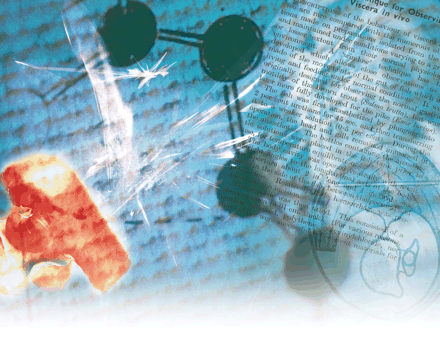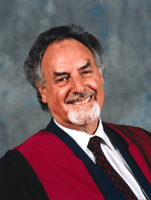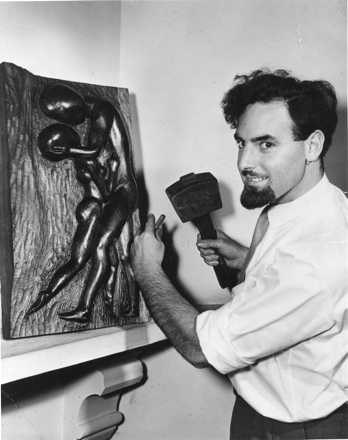GEOFFREY BURNSTOCK: Most Highly Cited Scientist

If you haven’t taken the time to read up on purinergic signaling, consider this: of the ten most cited scientists in pharmacology for the past decade, no less than four work on biological responses to purines and related molecules1. If you’re surprised by this statistic, you’re in good company: until a few weeks ago, the fact was also unknown to Geoffrey Burnstock, the single-most cited researcher on the list and the scientist who coined the term “purinergic nerves” in the early 70s. (He is also about to launch a new journal devoted to the discipline, Purinergic Signalling, as Editor-in-Chief ). At that time, Burnstock’s depiction of ATP as an important neurotransmitter was met with considerable skepticism, even among those who otherwise accepted and studied the intracellular actions of purines. This year in June, Burnstock appeared at the Purines 2004 Meeting, appropriately enough, to deliver the “First Burnstock Lecture.” Many of the symposia presenters openly acknowledged Burnstock’s work in driving the purinergic field to its present state of fruition; this acknowledgment, along with the genuine affection that typically accompanies it, seems to surprise as much as it delights Burnstock, who remembers very well the many meetings where his results went hotly challenged. The following interview took place at Purines 2004 in Chapel Hill.
MI: One of the developments at the Purines 2004 meeting is the “First Burnstock Lecture.” What is the significance of this named lecture?

GB: Well, it sounds like they’re going to perpetuate it!
MI: You sound kind of surprised.
GB: Of course I’m surprised! I came up with this concept in Pharmacological Reviews in 1972, and nobody believed it. At the first Purines Meeting in Canada way back in the late 70s, probably 95% of the science concentrated on adenosine. And my stuff [on signaling through ATP] was very much frowned on. There were certain very strong figures—very influential figures, and gifted— and one of them was Robert Berne, who had early on claimed that adenosine was the physiological regulator of blood flow during hypoxia and ischemia in the heart and other organs. He was charming and he was clever, and although he collected adenosine from the hypoxic heart, he was totally opposed to the fact that it might be originating as ATP. We now know much about the ectoenzymes that rapidly break ATP down after its release from cells, but Berne was an important figure and very influential. At the opening party of the second Purines Meeting a while later, I was suddenly trapped in the corner by several scientists who were also very opposed to the idea of ATP as an extracellular regulator, and being an ex-boxer, I got very worried because I had the sense that it was going to become physical. People were very passionately against this!
MI: Beyond the human psychological resistance to something new, perhaps, was there any scientific basis for objecting to purinergic signaling through ATP?
GB: There was, in a way. ATP, with the great discovery of the Krebs cycle, belonged to the biochemists! It was an intracellular energy source—and it was taken as something of an insult to suggest that such a ubiquitous energy molecule could possibly be involved in extracellular signaling! Many opponents never even read the carefully gathered evidence in my papers, which satisfied all the criteria for establishing ATP as a neurotransmitter.
MI: What brought you to focus on ATP in this role?
GB: You know, for decades there were only two transmitters that were recognized in the autonomic nervous system: noradrenaline and acetylcholine. In the early 60s we published a series of papers demonstrating non-adrenergic, non-cholinergic (NANC) transmission to smooth muscle cells. So, I had to try to identify the neurotransmitter involved: peptides and amino acids, which were beginning to be thought of as transmitters in the brain, monoamines other than noradrenaline, and so on. I began testing all these agents in our NANC system. There had been several hints in the early literature about ATP. A classic paper in 1929 by Drury and Szent-Gyorgy showed potent extracellular actions of ATP in the heart and blood vessels—that’s about the time when ATP was discovered! And then another very important, landmark paper was in 1959 by Pamela Holton, who died soon after. What she did was to demonstrate the liberation of ATP by antidromic stimulation of sensory nerve collaterals to the ear artery. Having discovered NANC nerves and trying everything without much success to see what substance mimicked this response, I came across these hints from the literature and gave ATP a try, totally objectively. And there were other odd hints. ATP was used therapeutically in France in the 50s, where the idea was to provide the patients with a source of energy. And in fact it made people walk better and reduced angina attacks. We now know that ATP acts on P2Y receptors on endothelial cells to release nitric oxide; this causes vasodilatation, which is a more likely explanation for these beneficial effects.
MI: In addition to sparking some debate by bringing the phrase “purinergic nerves” into use, you also met with resistance when you questioned the Dale hypothesis.
GB: I wrote a very gentle paper—there was a question mark in the title!—in which I brought up a number of inconsistencies in what became known as Dale’s Principle (that each neuron produces only a single transmitter), which made it look as though it wouldn’t prove to be a universal principle. And it’s turned out that most nerves communicate by multiple neurotransmitters! It was very carefully written, but at the time, the idea was regarded as heresy.
MI: So, emotionally, were you driven by the controversy —did you find it exciting, or did you try to exclude that aspect from the science you were pursuing?
GB: I didn’t mind being on the wrong side of the fence—it never bothered me. I found it quite exciting to be fighting in my corner. I was a fighter by spirit and always a bit of a rebel. I came from a family of boxers; I had ten uncles, mostly army champs, and they made me box with my cousins from the age of three. It was rather expected that maybe I would turn professional. But my father died when I was sixteen, and at that time I thought I’d like to get educated, which he also had wanted for me. He had been badly wounded in the Battle of the Somme, and so he had never had the chance for an education. Anyway, I decided that I wanted to study medicine.
MI: Why did you want to go into medicine??
GB: I fancied it—I was a romantic, I think. I’ll never forget my interview at Saint Mary’s Hospital in London. There were all these very well educated boys, and there I was, with the wrong clothes, the wrong accent, the wrong everything! One of the interviewers asked me what I would do if I did manage to get into medicine, and I said, “Well, what I’d love most of all would be research!” He responded by telling me that I was a stupid boy and that I didn’t have a chance. As I walked slowly away, a fellow applicant who’d been in and out of the interview with ease told me that he had been accepted—even though he wasn’t sure he really wanted to study medicine—because his father was a doctor. That was the first time I realized how the class system worked. Ultimately, the only place that would accept me was for theology—and I was already an atheist! So, my first studies [at King’s College London] were in theology, but I was also allowed to study mathematics and physics, and then for a zoology degree in the department that was headed by Jim Danielli. I stayed in that department to get my PhD!
MI: Were you interested in nerve function at that time?
GB: Well, I got into the business in a totally random way. I chose my first PhD supervisor because she was a good lecturer and a nice woman—I didn’t know anything about her research program. I turned out the first day—I’ll never forget it—and I said, “I’m dying to do research, just tell me what to do and I’ll do it.” And she said, “First you’ve got to go away for six months and find the gaps in the literature.” In retrospect, this was totally idiotic. How can you find the gaps unless you read it all?! I had to decide randomly whether to work on the brain or the gut, and then whether to go after the biochemistry of digestion, or motility! And then my approach was bizarre: I chose to focus on gut motility, but I decided not to work with organ baths—I thought that one should take an in vivo approach. So, I picked two fish—goldfish that eat continuously, and pike, which eat once every two months. I put transparent materials, including condoms, over windows cut in their bodies and my first paper, in 1957, was in Nature of a fish with a window! By that time J.Z. Young had agreed to be my PhD supervisor, because he was interested in fish gut physiology—a great man who did particularly important work on the squid giant axon. And then I persuaded Wilhelm Feldberg, who also had a soft spot for oddballs, to take me as a postdoc in his department at the National Institute of Medical Research in Mill Hill. There I linked up with a young man [Ralph Straub] who had worked with Stämpfli, the inventor of the sucrose gap technique. It wasn’t expected that the method should work for smooth muscle, but there are gap junctions between smooth muscles, which provide a low-resistance pathway and it worked a dream! When I joined Edith Bülbring in the pharmacology department at Oxford, my heart sank because she described a “good year” as one where she managed to get six penetrations, with microelectrodes, that measured around fifty millivolts. I couldn’t face that level of difficulty—I felt that I had to have at least seventy-five percent success, not ten percent success! I used the new sucrose gap technique for recording from smooth muscle, so that we didn’t have to depend on the tricky use of microelectrodes. My first six months at Oxford were spent mostly in the workshop, which made my colleagues uneasy about me. But I was designing a sucrose gap, which allowed me to go out to lunch and return to 300 feet of marvelous film showing what previously would have taken much time to achieve with microelectrodes.
MI: From your postdoctoral work at Oxford you ended up in Australia. How did that happen?
GB: Well, I first got a Rockefeller fellowship to America and I spent time in Illinois with Ladd Prosser in biophysics, and then I also got to know Steve Kuffler and spent time in Woods Hole—it was marvelous to be around these gifted people. And then I had to decide whether to go back to Oxford or stay in America. But I decided to go to Australia, where Mollie Holman and Mike Rand were from, people I had met and liked very much while I was at Oxford. So I went to the Zoology Department in Melbourne. Mollie was set up with her lab in the Physiology Department, and she and I got an NIH grant together. I became Chairman of Zoology within five years.
MI: It sounds as if you were getting a good bit of recognition as a young scientist—despite a roundabout way of getting an education.
GB: I suppose so, but to tell you the truth, I didn’t think about it. And I had some painful experiences, too. One of the things that I decided, when I was about eighteen, was that I really wanted to be a Spanish Flamenco guitarist. I loved it. I was somewhat disillusioned with the world (I tried to become antisocial but it didn’t exactly fit my character!) and I drove down to Spain on a primitive motorbike, and for two summers, I learned to play. And then the time came for me to play for an audience, knowing that if they liked me they would dance. Well, nobody danced. I realized I was lousy! But the experience taught me a very important philosophical point that I have used myself and in advising students, that is to make the most of your strengths and not insist on playing to your weaknesses. I think that’s terribly important.
MI: Why do you think you developed that sensibility? You didn’t receive that kind of thoughtful guidance as a student.
GB: No, I didn’t get it, but it’s so obvious. The human elements are vital. People think that scientists are purely objective-thinking beings, but when you really look at what scientists do, they have little corners with flowers, photos and things to make them feel good and are sensitive to their environment and relationships with their colleagues. It’s not a cold business at all—it shouldn’t be.
MI: You stayed in Australia for over fifteen years—what brought you back to London?
GB: Well, there are certain stages to careers, and when I was in my mid forties, people began offering me jobs. I went to look at the Chair in Physiology at King’s College London, and while I was there, the people at University College London approached me about the Chair of Anatomy and Embryology at UCL. Anatomy had been J.Z. Young’s great department, where I did my PhD, so this was a great honor. It was extraordinary that I got quite a few offers from universities in the USA and Australia around the same time—I guess I was at the age that people look for.
MI: Well, it couldn’t have been only the age—what was going on with your work?
GB: Well, the work was going well, although the purinergic story hadn’t really broken then. I don’t know. I have an energy and an enthusiasm that maybe got through to people. I made a special effort to recruit outstanding original people and to nurture their individual development (anything short of anarchy was OK with me). And I’m a great believer in the multidisciplinary approach, so I like to bring different people and different techniques together. During my years heading the Department in London, I led a research group of thirty-five to forty people, with molecular, biochemistry, electrophysiology, biophysics, tissue culture, electron microscopy and pharmacology labs—we had all the facilities we needed to answer questions. The department got one of the highest research ratings in England, and by the time I left, there were twenty-six full professors, and we ended up with six Fellows of the Royal Society.
MI: And how did you transition into your present position as Director of the Autonomic Neuroscience Institute?
GB: Well, the tradition in England is that when you get to be sixty-five you retire. But I didn’t want to retire, and I had built such a big department that it didn’t appeal to everybody who might be asked to take over. I was sixty-seven before they found somebody, and then they set me up very nicely in this brand new institute in an adjacent hospital, ten minutes away. Four weeks ago, when I got to be seventy-five, they stopped my salary and officially closed further growth of the Institute, but I still have fourteen MD and PhD students finishing up—I have to honor that. But it’s very frustrating—because in Australia and America, if you’re still publishing twenty to thirty papers a year and bringing in money, as I do, you’re encouraged to continue. For example, we’ve just published a paper in Nature Medicine that I’m very excited about, having to do with an amazing drug [arimoclomol, a coinducer of heat shock proteins] potentially useful in neurodegenerative disease. And it’s ironic that last year or the year before they gave me two of the highest medical degrees that you can get in England: Honorary Fellow of the Royal College of Surgeons and Honorary Fellow of the Royal College of Physicians. (I didn’t tell them that I hadn’t been able to get in to medical school!)
MI: So, with the eventual closing of your Institute, you’re about to face another transition?
GB: Well, surprisingly, there are about eight labs around the world that seem to want to involve me in their experimental work. And what excites me now is the therapeutic potential of our research - at this meeting on purinergic signaling, it’s clear that the emphasis is moving that way. Three or four years ago, I started getting into purinergic signaling in embryology. If my view is right that ATP is the most primitive messenger in the body, it’s going to be big in studies of development and in stem cell research—I feel optimistic about this. And in addition to being an editor of about twenty journals, including Editor-in-Chief of Autonomic Neuroscience: Basic and Clinical, I’m about to start as founding Editor-in-Chief of a new journal focusing on purinergic signaling. I’ve put together a very strong editorial board that really excites me.
MI: So, it sounds like you’re going to be busy for quite a while!
GB: I hope so! I want to be busy. It’s delightful to sit around with the grandchildren, but I’ve got to work. I can’t help it—it’s too exciting!
Footnotes
-
↵1 From ISI Essential Science Indicators, covering the years 1993–2003. See http://www.incites.com/scientists/pha-10aug2003.html.
- © American Society for Pharmacology and Experimental Theraputics 2004

Geoffrey Burnsotck in Melbourne in about 1960, soon after he started carving wood (here, mahogany) as a hobby.



